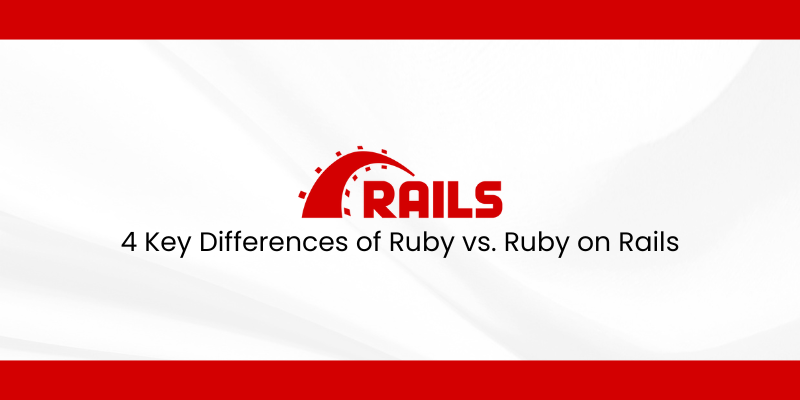The programming community is familiar with Ruby and Ruby on Rails, but because of their names' similarity, developers frequently misunderstand them. The web development framework Ruby on Rails and the versatile programming language Ruby serve distinct purposes. Developers and companies must recognize their differences in order to leverage their distinct capabilities. In order to provide clarity and insight into their use cases, this article will examine the four main distinctions between Ruby and Ruby on Rails.

Ruby is a general-purpose, object-oriented programming language that Yukihiro Matsumoto developed in 1995. It was created with simplicity and efficiency in mind, with a focus on user-friendly syntax. Ruby is used by developers for a wide range of tasks, including data processing, web applications, and automation script preparation.
- Object-oriented programming (OOP) at its core.
- Dynamic typing and flexibility.
- Extensive libraries and gems for varied functionalities.
- Emphasis on developer happiness with clean, readable code.
Ruby on Rails (often called Rails) is a web application framework built on Ruby, introduced by David Heinemeier Hansson in 2004. It streamlines web development by offering pre-written code and standards, freeing developers to concentrate on creating useful apps rather than starting from scratch.
- Convention over Configuration (CoC) approach.
- DRY (Don't Repeat Yourself) principles to avoid redundancy.
- Built-in support for web servers and databases.
- Streamlined process for creating MVC (Model-View-Controller) applications.
Ruby’s versatility extends beyond web development. It’s commonly used for tasks like:
- Writing automation scripts for system management.
- Building command-line tools.
- Data analysis and processing.
- Game development.
Ruby empowers developers to work on diverse projects, making it an all-encompassing language.
Ruby on Rails focuses exclusively on creating web applications and websites. It includes tools to:
- Handle database interactions efficiently.
- Manage user authentication systems.
- Design scalable APIs.
- Implement front-end and back-end logic seamlessly.
The framework is structured to streamline repetitive web development tasks, ensuring faster project completion.
The Ruby programming course is applauded for being simple to learn and comprehend. Ruby is a good first language for people who are novices to programming due to its syntax, which is frequently intuitive to newbies. It's syntax mimics natural language, reducing the complexity of writing and understanding code.
Learning Ruby on Rails requires a foundational understanding of Ruby, as Rails builds upon Ruby’s principles. Beyond Ruby, developers need to grasp concepts like MVC architecture, database migrations, and routing. While the initial learning curve is steeper, the framework’s efficiency becomes apparent once mastered.
Example:
Writing a "Hello, World!" program in Ruby is straightforward:
ruby
puts "Hello, World!"
Developing a basic web application in Ruby on Rails involves generating controllers, models, and views, which demands a deeper understanding.
Ruby boasts a dedicated community that has developed thousands of libraries and tools, referred to as "gems," which simplify various programming tasks. Some popular Ruby gems include:
Sinatra: A lightweight web application library.
Pry: A powerful interactive shell for debugging.
The community continuously supports and evolves the Ruby programming language.
Ruby on Rails has its own ecosystem, with gems and tools tailored for web development. Notable gems include:
Devise: For authentication systems.
RSpec: For behavior-driven development.
Active Record: For object-relational mapping (ORM).
Rails developers benefit from detailed documentation, tutorials, and forums, making it easier to find solutions and collaborate.
Although Ruby and Ruby on Rails have the same name and are closely related, their characteristics and uses are very different. Ruby is a flexible programming language that can be used for a wide range of tasks, and Ruby on Rails course is a specialized architecture for fast-developing web applications. Developers can improve productivity and outcomes by choosing the best tool for their projects if they are aware of these differences.
If you are exploring the programming world or considering your next web project, keep these distinctions in mind. Both the flexibility of the Ruby programming language and the effectiveness of the Ruby on Rails framework have special advantages.